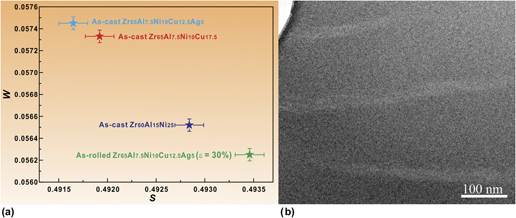Article contents
Correlation between the atomic configurations and the amorphous-to-icosahedral phase transition in metallic glasses
Published online by Cambridge University Press: 22 June 2018
Abstract

Positron annihilation spectroscopy and differential scanning calorimetry were used to evaluate the changes of the atomic configurations in Zr-based metallic glasses (MGs) due to alloying and plastic deformation. The correlation between the atomic configurations of MGs and the amorphous-to-icosahedral phase transition due to heating was investigated. The results indicate that the free volume frozen in the as-cast Zr60Al15Ni25, Zr65Al7.5Ni10Cu17.5, and Zr65Al7.5Ni10Cu17.5Ag5 MGs substantially decreases in sequence. More excess free volume is introduced in Zr65Al7.5Ni10Cu17.5Ag5 MG due to cold rolling and milling. The annihilation of free volume due to alloying considerably stabilizes the icosahedral structure of MGs, which enhances the nucleation and growth of quasicrystals upon heating. However, the nucleation and growth of quasicrystals are considerably suppressed in Zr65Al7.5Ni10Cu17.5Ag5 MG due to cold rolling and milling, during which the more introduced excess free volume results in substantial destruction of short-range order with 5-fold symmetry. The present work further provides direct evidence for the prevalence of icosahedral short-range order in MGs.
Information
- Type
- Article
- Information
- Copyright
- Copyright © Materials Research Society 2018
Footnotes
Contributing Editor: Jurgen Eckert
This author was an editor of this journal during the review and decision stage. For the JMR policy on review and publication of manuscripts authored by editors, please refer to http://www.mrs.org/editor-manuscripts/.
References
REFERENCES
- 2
- Cited by

